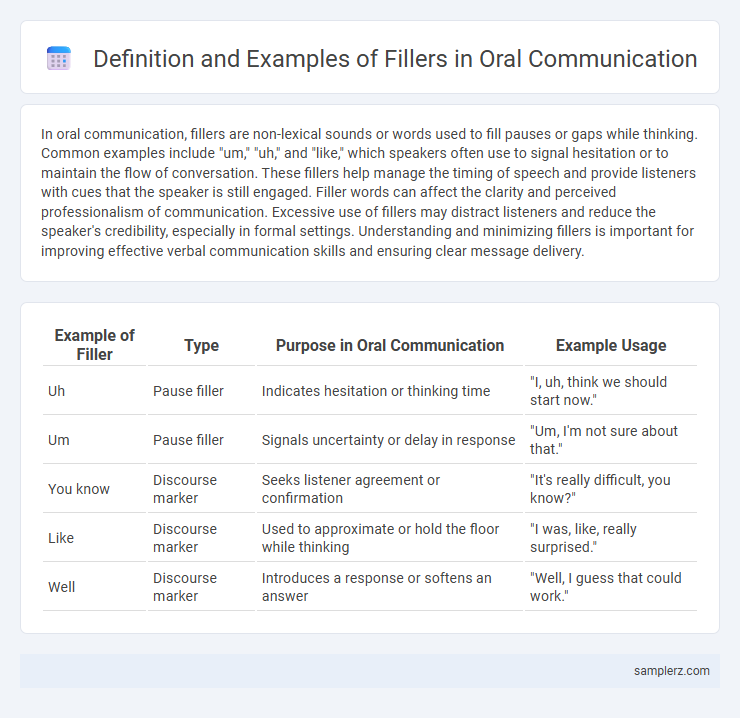In oral communication, fillers are non-lexical sounds or words used to fill pauses or gaps while thinking. Common examples include "um," "uh," and "like," which speakers often use to signal hesitation or to maintain the flow of conversation. These fillers help manage the timing of speech and provide listeners with cues that the speaker is still engaged. Filler words can affect the clarity and perceived professionalism of communication. Excessive use of fillers may distract listeners and reduce the speaker's credibility, especially in formal settings. Understanding and minimizing fillers is important for improving effective verbal communication skills and ensuring clear message delivery.
Table of Comparison
| Example of Filler | Type | Purpose in Oral Communication | Example Usage |
|---|---|---|---|
| Uh | Pause filler | Indicates hesitation or thinking time | "I, uh, think we should start now." |
| Um | Pause filler | Signals uncertainty or delay in response | "Um, I'm not sure about that." |
| You know | Discourse marker | Seeks listener agreement or confirmation | "It's really difficult, you know?" |
| Like | Discourse marker | Used to approximate or hold the floor while thinking | "I was, like, really surprised." |
| Well | Discourse marker | Introduces a response or softens an answer | "Well, I guess that could work." |
Understanding Fillers in Oral Communication
Fillers in oral communication, such as "um," "uh," and "like," serve as temporary pauses that allow speakers to organize thoughts without losing the listener's attention. Recognizing these fillers helps improve conversational flow and comprehension by signaling hesitation or emphasis rather than a lack of knowledge. Understanding the role of fillers enhances communication clarity and supports more effective listener engagement.
Common Fillers Used in Everyday Speech
Common fillers used in everyday speech include words and sounds such as "um," "uh," "like," "you know," and "so." These fillers often serve to signal hesitation, hold the speaker's turn, or provide time to think during spontaneous conversation. Excessive use of fillers can impact clarity and the perceived confidence of the speaker in oral communication.
The Role of Fillers in Enhancing Conversations
Fillers such as "um," "ah," and "you know" play a crucial role in oral communication by providing speakers with brief pauses to organize thoughts and maintain the flow of conversation. These vocal pauses signal to listeners that the speaker is still engaged and processing information, which enhances conversational coherence and reduces interruptions. Effective use of fillers can improve listener perception by creating a natural rhythm and fostering a more interactive communication environment.
Examples of Verbal Fillers Across Languages
Verbal fillers such as "um," "uh," and "er" are common in English, while in Japanese, "ano" and "etto" serve similar functions to fill pauses in speech. Spanish speakers often use "este" and "pues" as verbal fillers, reflecting hesitation or a moment to think. In French, fillers like "euh" and "ben" play a crucial role in maintaining conversational flow and signaling hesitation during oral communication.
Why Do People Use Fillers When Speaking?
People use fillers like "um," "uh," and "you know" in oral communication to manage the flow of conversation while they think or plan their next words. These vocal pauses signal hesitation, help maintain the listener's attention, and give speakers extra time to formulate coherent ideas. Fillers also play a social role by indicating that the speaker is not finished, preventing interruptions and supporting smoother interpersonal communication.
Positive and Negative Effects of Fillers
Fillers such as "um," "like," and "you know" are common in oral communication and can positively signal hesitation or allow the speaker time to organize thoughts, enhancing clarity and listener comprehension. However, excessive use of fillers may undermine speaker credibility, distract listeners, and reduce the overall effectiveness of the message. Understanding the balance and context in which fillers are used is crucial for effective verbal communication.
Fillers in Professional Versus Casual Communication
In professional communication, fillers such as "um," "ah," or "you know" are often minimized to maintain clarity and credibility during presentations or meetings. Casual conversations tolerate more frequent use of fillers, serving as natural pauses or hesitation markers that facilitate smoother interaction without disrupting the flow. Understanding the context and audience helps speakers strategically reduce fillers in formal settings while allowing their use in informal dialogue to convey authenticity and engagement.
Reducing Filler Usage in Public Speaking
Reducing filler usage in public speaking enhances clarity and audience engagement by minimizing words like "um," "uh," and "like." Effective techniques include practicing deliberate pauses, increasing familiarity with the material, and recording speeches for self-assessment. Consistent training in these methods supports speakers in delivering more confident and impactful presentations.
Cultural Variations in Filler Usage
Filler words such as "um," "uh," and "like" vary significantly across cultures, reflecting different communication styles and social norms. In Japanese, the filler "eto" serves as a hesitation marker, while in Spanish, "este" plays a similar role, indicating pauses in speech without interrupting the flow of conversation. Understanding these cultural variations in filler usage enhances cross-cultural communication and reduces misinterpretation in oral interactions.
Practical Tips to Identify and Manage Fillers
Common fillers in oral communication include "um," "uh," and "like," which speakers often use unconsciously during pauses. Practical tips to identify these fillers involve recording conversations and noting repetitive hesitation words that disrupt speech flow. To manage fillers effectively, practicing deliberate pauses, increasing self-awareness through feedback, and engaging in structured speaking exercises can significantly reduce their frequency and improve clarity.

example of filler in oral communication Infographic
 samplerz.com
samplerz.com